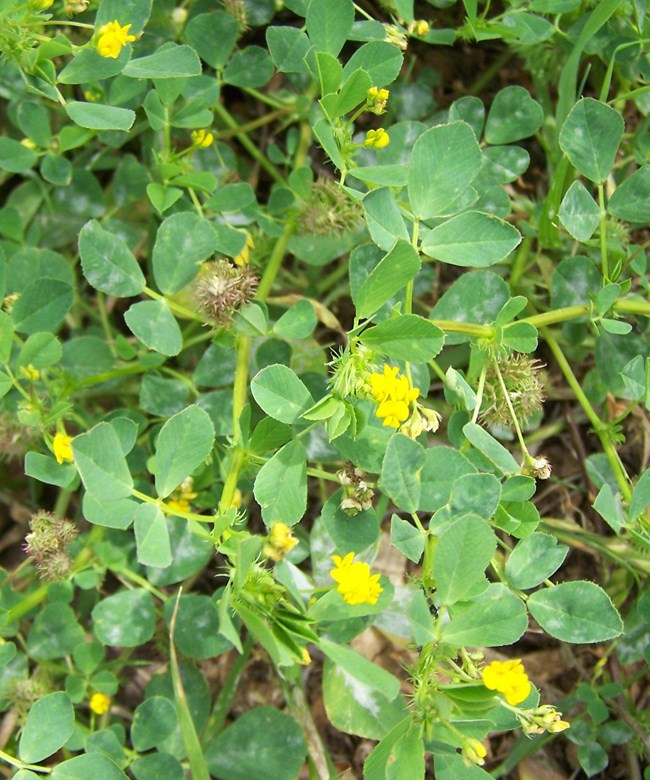Last updated: January 12, 2021
Article
Invasive Exotic Plant Monitoring in Zion National Park, 2018

Long-term monitoring shows that control efforts on invasive exotic plant (IEP) populations can be effective. In Zion National Park, two IEP species have declined after being targeted for reduction. Areas of high use tend to have the most exotic plants.
What Are Invasive Exotic Plants?
Invasive exotic plants (IEPs) are non-native species whose introduction to an environment does or is likely to cause economic or environmental harm, or harm to human health. IEPs can alter ecosystems at multiple scales—threatening wildlife, natural landscapes, and recreational opportunities. They can reproduce prolifically, rapidly colonize new areas, and displace native species.
Invasive plants fill different ecological roles than the native plants they replace. As a result, the needs of species that depended on the native vegetation may go unmet, potentially creating a cascade of ecological effects.
The good news is that if discovered before they have a chance to take hold, IEP populations can be eradicated from parks. Small populations are cheaper and easier to control than large populations. Therefore, early detection is critical.
What Can Be Done?
To provide early warning of weed invasions and help park managers prioritize control efforts, the Northern Colorado Plateau Network (NCPN) monitors invasive exotic plants in eight National Park Service units. First, network and park staff create a list of priority IEPs for each park. Then, on a rotating schedule, a field crew looks for those IEPs along established monitoring routes. Along the routes, they stop and set up plots for additional data collection. The plot data allow network ecologists to estimate trends over time.
During data analysis, a Patch Management Index (PMI) helps identify the scale of the problem presented by each patch of exotic plants. PMI multiplies the size of each patch by the amount of each patch that is covered in weeds to arrive at a composite score. The PMI score is assigned to a class ranging from very low to very high.
To be useful, PMI must be considered in combination with species and patch numbers. In many cases, targeting patches with very low or low PMI allows managers to keep small patches from growing into bigger problems. On the other hand, a species with many patches of very low or low PMI may be harder to treat than a different species with just a few patches of high or very high PMI.

Karan A. Rawlins, University of Georgia, Bugwood.org, CC 3.0
Recent Monitoring at Zion National Park
During monitoring on May 30–June 4, 2018, a total of 17 different IEP species were recorded along 110 kilometers (69 mi) of 25 monitoring routes and 195 transects at Zion National Park. Of these, seven were priority species that accounted for 288 separate patches. Three-quarters of all patches (75%) were classified as “very low” on the patch management index scale, suggesting that effective control or eradication is possible through local management actions. On average, roads had more priority IEP patches per kilometer than trails.
Little bur-clover (Medicago minima) was the most prevalent priority species, representing 60% of all recorded patches. The next-most common priority species were bulbous bluegrass (Poa bulbosa), Bermudagrass (Cynodon dactylon), and Siberian elm (Ulmus pumila). Together, these four species represented 94.8% of all patches recorded in 2018. Scotch thistle (Onopordum acanthium) and Johnsongrass (Sorghum halepense) have both declined since monitoring began, likely due (at least in part) to weed-control efforts.

Cheatgrass (Bromus tectorum) and Russian thistle (Salsola sp.) are so widespread that they are not recorded along routes—but are monitored in transects. In addition to cheatgrass and Russian thistle, observers recorded little bur-clover, bulbous bluegrass, and summer cypress (Bassia scoparia) in transects. IEPs were found on 74% of transects in 2018. Cheatgrass was by far the most widespread IEP species, present in 71.3% of transects sampled. Cheatgrass also had the highest percent cover of any IEP species, averaging 1.09% across all transects.
| Scientific name | Common name |
|---|---|
| Avena fatua | wild oat |
| Bassia scoparia* | summer cypress |
| Bromus tectorum** | cheatgrass |
| Cirsium vulgare | bull thistle |
| Convolvulus arvensis | field bindweed |
| Cynodon dactylon* | Bermudagrass |
| Eleaegnus angustifolia | Russian olive |
| Lathyrus latifolius | perennial sweetpea |
| Marrubium vulgare | common horehound |
| Medicago minima* | little bur-clover |
| Onopordum acanthium* | Scotch thistle |
| Poa bulbosa* | bulbous bluegrass |
| Rubia tinctorum | madder |
| Salsola sp.** | Russian thistle |
| Sorghum halepense* | Johnsongrass |
| Tamarix sp. | tamarisk |
| Tribulus terrestris | puncture vine |
| Ulmus pumila* | Siberian elm |
| Verbascum thapsus | woolly mullein |
*Priority species. **Recorded in transects only.
Recommendations
Control efforts should continue in high-use, main-canyon areas that tend to have the most invasive plants: Watchman Campground and Visitor Center, Oak Creek and Administrative Area, and the Pa’rus and Grotto trails. It should also be noted that overall IEP percent cover was very low, and many monitoring routes had either few or no priority invasive plants. Efforts should be made to keep these areas IEP-free.
Prioritizing treatment of small-scale IEP patches can effectively prevent future spread and allow eradication. For widespread species, such as little bur-clover, the large number of patches with very low and low PMI indicates these species are sparsely scattered across a broad landscape, and controlling these populations will mean travel across broad areas. Managers can consider species traits (e.g., how likely and quickly plants may spread) and environmental conditions (precipitation and temperature), and combine this information with patch numbers and PMI values when determining treatment priorities.
In 2020, NCPN will return to Zion NP to finish the third rotation of invasive plant monitoring.
For more information, see A. Washuta and D. W. Perkins, Invasive Exotic Plant Monitoring in Zion National Park: 2018 Field Season.
